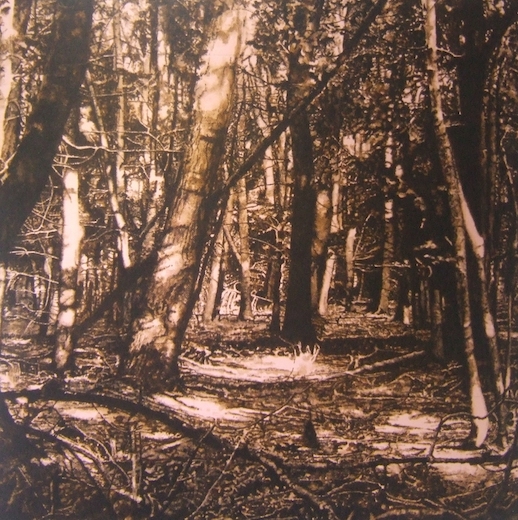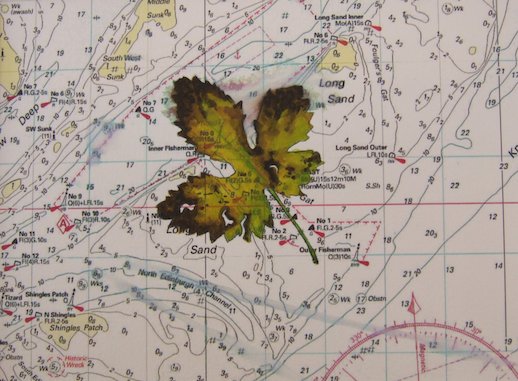Philip Smith is a painter who went from drawing straight lines to making paintings that show how the light looks in Forge Wood, Kent.
Interview: Emma Warren
Have you always painted nature?
For a long time I was an abstract painter, doing quite austere, geometric stuff that reduced itself over many years to just verticals and horizons. The paintings got to such a point where I couldn’t ignore the fact that the horizontal line was a horizon so I just decided to embrace it. I didn’t want to depict a particular place and I wanted to be somewhere outside of normal human encounter. I started making paintings of found photography of seascapes.
Have you been to sea at all?
No. I looked into getting a berth on a cargo ship. It was very expensive and I didn’t have the time. I’m not sure what it would have achieved. I always do a lot of reading around whatever subject I’m working on. I read Barry Lopez, he wrote a very famous book about the Arctic. A lot of novels about the sea, and poetry, like John Burnside. His work strikes so many chords, especially the space between what language does and doesn’t say. And he uses a lot of lists, like Richard Long, which is always good. I’m always on the look out for phrases. I read something about the Bristol mud flats recently where the writer described ‘the astonishment of grass’ in spring. I like that.
How did water end up turning into leaves?
I was trying to think of something I could use that had a similar weight, but was also suitably abstract and pliable. Being an urbanite and not partaking of nature too often, [I needed] what was to hand. If you take them out of the tree context they become full of possibility.
What did you notice about leaves once you started looking at them more closely?
Once detached from the tree they’re in this act of decay. It’s this moment. If you capture them off the ground you’re in this moment between things, another edge if you like. I’m not religious in any way shape or form but one of the fascinations in the sea and leaves and the woods is this difference between enlightened knowledge, which the study of nature brought into being, and the supposed spiritual. The leaf, in the act of falling, suspended in time, is somewhere between life and death.
I’d noticed you painted leaves in the act of decay but it hadn’t occurred to me that you were painting them in the act of falling…
They’re suspended. I only did one painting where the leaves are decayed, crinkling. That was painting from the actual leaf in front of me. All of the others have been filtered through a process, scanned, flattened out, photographed, so I’m only confronting a 2D image. It’s putting a distance between what might become an illustrative, botanical drawing and it becoming something else.
How do you choose a leaf?
I found over time that some leaves are boring to paint. Too much green annoys me. I like those that are troubled, or have some marks or decay, or mould. Some elements of discomfort, a scar, always more interesting to paint. You’ll see on some of these there’s a deliberate staining beyond the edge of the leaf, partly to take it away from being illustrative, but also because it belongs on the confines of a painted surface. It’s also a bleed, which might lead you to thoughts of death and decay, if you so wish.
What about when the leaves you paint on top of other things, like the ordnance survey map?
I wanted to make leaves into falling stars, meteors. It’s navigation. The maps are of the Thames Estuary that clearly show shipping channels. I wanted to put a constellation of my own design over it to make a connection between navigation, star-gazing and this dead object.
Do you like maps?
One of the interesting things about maps is that they’re a way of reading yourself at a point in time. It says so much about where we are, as to what shape a map takes. The development of our knowledge is written in the map of its time. The scale, size, position of the continents, the Westernisation of the globe, that’s changed over time.
How did you go from leaves to trees?
I became interested in not so much the woods, but the light contained in woods. I think that’s probably where my paintings will go – more light than wood.
Something Deeper Than Shadow was a test to see if I could do it. Also putting back in the vertical and horizontal. More vertical, actually. Humanising them a bit more, giving scope to the viewer to feel more part of the space of the painting.
Is this Forge Wood again?
Yes. The source material was selected from a series of images which I manipulated and then painted. Slow Dissolution, has shafts of light coming through it. I think my work touches on religious iconography which is weird because I’m an atheist. The light reveals but it dissolves and fractures and pulls things apart. This one is full of light but the light obliterates the subject. The thing you’re seemingly depicting is dissolving so what are you seeing? They woods or the light? The subject is the light as much as the tree.
The woods are a good place to see the light?
Woods are full of latent possibility, from folklore to all the current nature writing.
What about where you grew up. Was it towny or country?
I grew up in Leigh, an industrial cotton coalmining town with a canal, between Manchester and Liverpool. It was industrial when I was growing up, and now there’s no sign of it. There’s one textile factory that’s been kept and turned into flats. You’re not far from the Yorkshire Dales and Lake District, but the landscape of that part of Lancashire is Edgelands stuff. There’s a lot of scrub, places that sit between urban and the possibility of landscape.
Can you tell us about Speed of Mountains?
It was an exhibition me and a friend put on in Camberwell. I’ve been hankering after using that name for a long time. I comes from an artist called Ian McKeever. He says he likes to make things ‘at the speed of mountains’ and I like that a lot. I think time is a big part of my paintings, which take months to make, and it’s contained in the act of making. It’s an accumulation of things. It’s geological.
What are you going to paint next?
I’ve been taking photographs, looking through trees but facing directly at the sun, so I know something weird is going to happen when the light interacts with the lens. It’s an effort to expand on the light in the woods. It will have leaves and branches and maybe a tree and lots of light.



